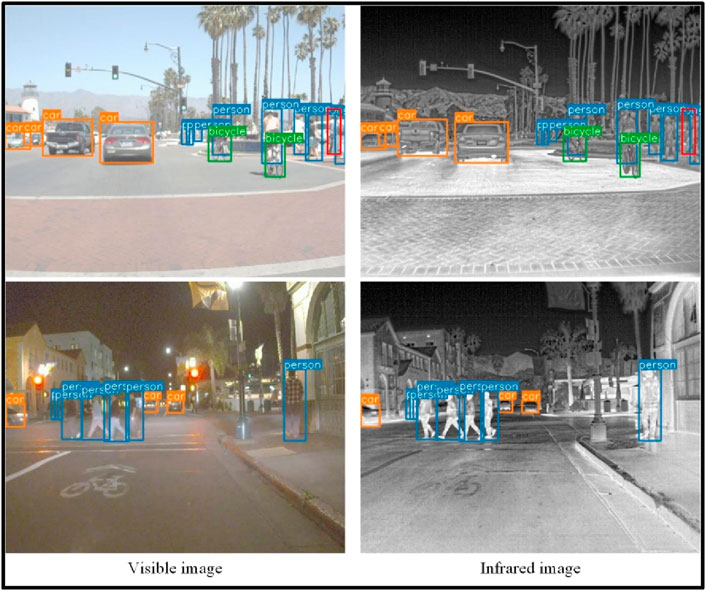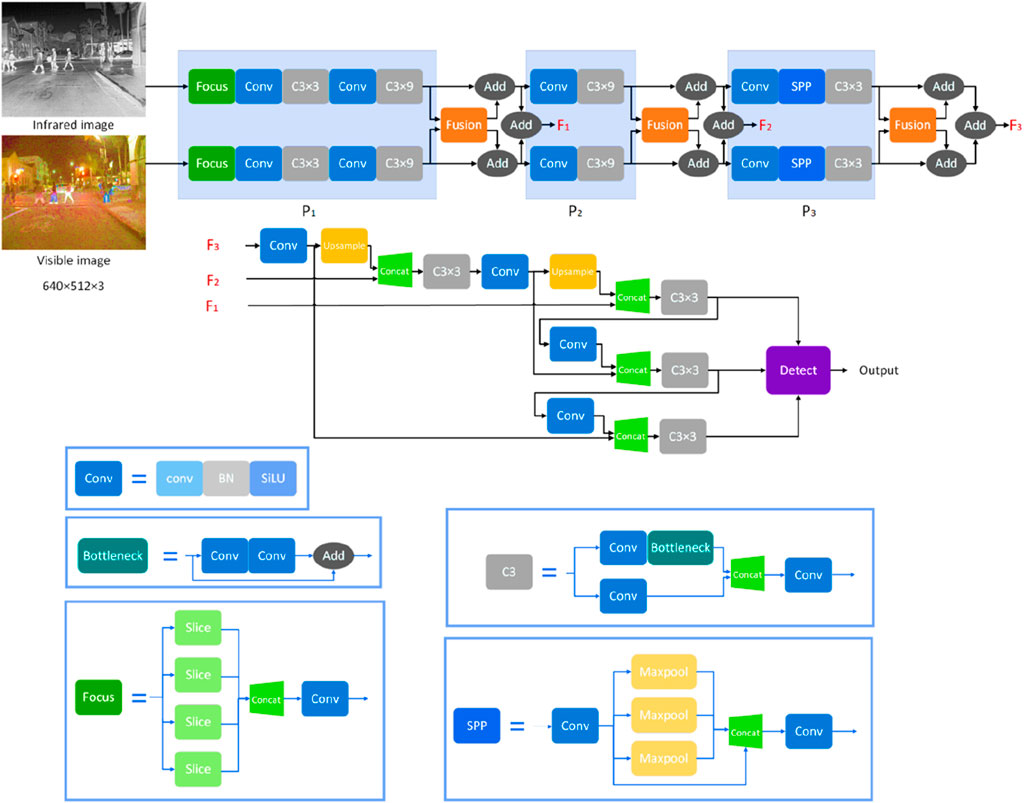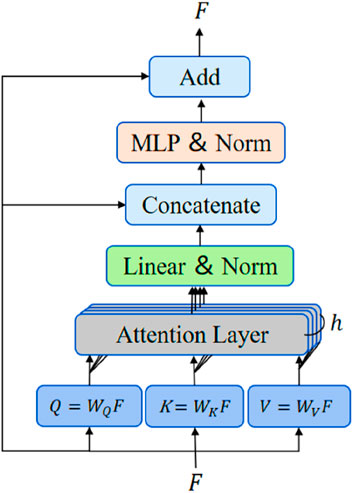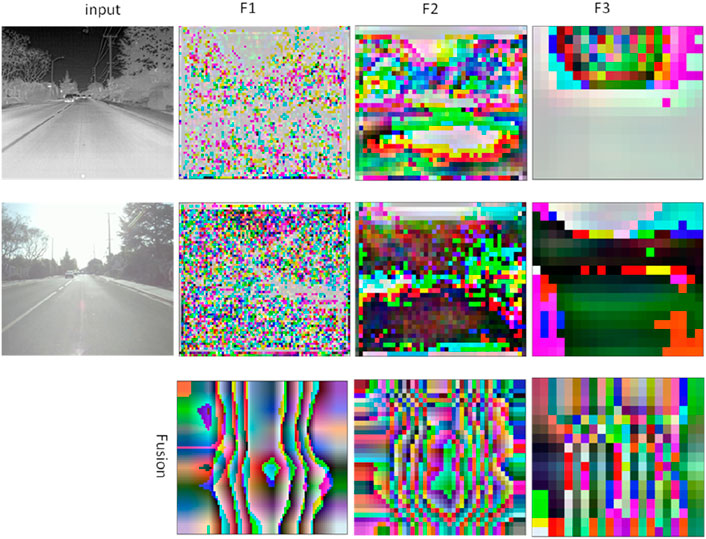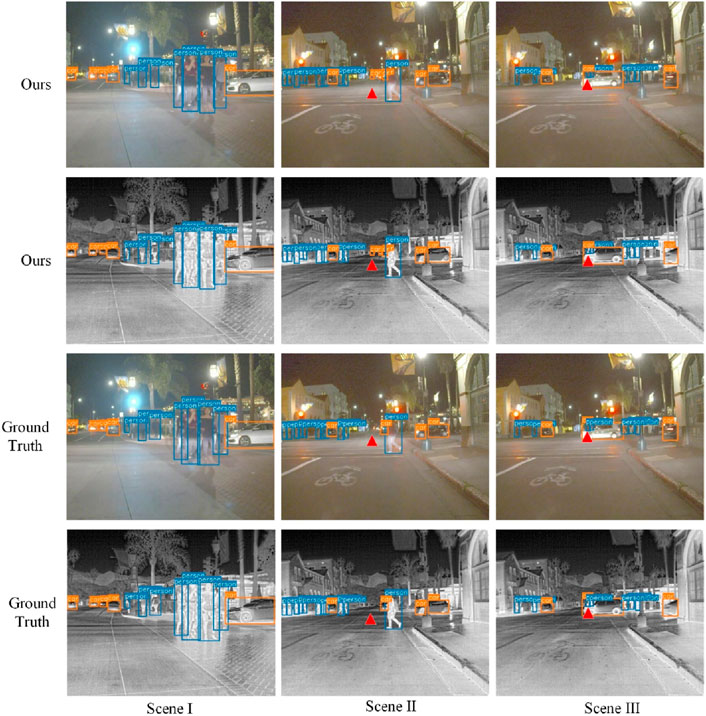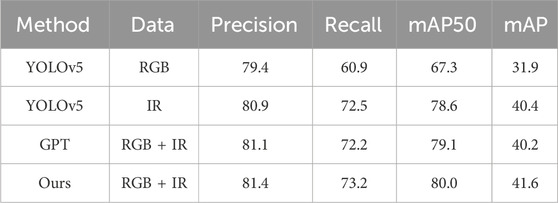- 1Shanghai Institute of Technical Physics, Chinese Academy of Sciences, Shanghai, China
- 2University of Chinese Academy of Sciences, Beijing, China
- 3Key Laboratory of Infrared System Detection and Imaging Technology, Chinese Academy of Sciences, Shanghai, China
The disparity between human and machine perception of spatial information presents a challenge for machines to accurately sense their surroundings and improve target detection performance. Cross-modal data fusion emerges as a potential solution to enhance the perceptual capabilities of systems. This article introduces a novel spatial perception method that integrates dual-modality feature fusion and coupled attention mechanisms to validate the improvement in detection performance through cross-modal information fusion. The proposed approach incorporates cross-modal feature extraction through a multi-scale feature extraction structure employing a dual-flow architecture. Additionally, a transformer is integrated for feature fusion, while the information perception of the detection system is optimized through the utilization of a linear combination of loss functions. Experimental results demonstrate the superiority of our algorithm over single-modality target detection using visible images, exhibiting an average accuracy improvement of 30.4%. Furthermore, our algorithm outperforms single-modality infrared image detection by 3.0% and comparative multimodal target detection algorithms by 3.5%. These results validate the effectiveness of our proposed algorithm in fusing dual-band features, significantly enhancing target detection accuracy. The adaptability and robustness of our approach are showcased through these results.
1 Introduction
Target detection is a common perception task in the field of remote sensing, and usually we use algorithms to extract human-eye vision-friendly feature information in order to achieve target detection. However, human visual perceptual information and detection system perceptual information are not uniform. Human vision-friendly feature information in any single modality can help humans to analyze the content in an image, but this does not fully reflect the true target perception capability of the detection system [1–3]. Due to the presence of a large number of visually unfriendly features, further exploitation of the perceptual capabilities of the system is possible, and cross-modal feature fusion is the key to exploit the target perception potential of the detection system [4–6]. Deep learning has emerged as a widely adopted methodology for addressing single-band target detection tasks, and it can be classified into two main categories: one-stage detection and two-stage detection algorithms. The conventional two-stage detectors encompass prominent models such as R-CNN [1], Fast R-CNN [2], Faster R-CNN [3], and Mask R-CNN [4]. In the two-stage detection paradigm, the initial step involves the generation of candidate regions, referred to as region proposals. These candidate regions are subsequently mapped onto the feature map to extract the corresponding feature matrices. These matrices serve as the foundation for conducting classification and regression tasks, ultimately enabling the determination of precise bounding box coordinates.
In the realm of fusion models, particularly in the context of autonomous driving, there have been studies exploring the combination of You Only Look Once (YOLO) and radar sources [5, 6]. These fusion models aim to leverage the strengths of both YOLO, a popular object detection algorithm, and radar sensors to enhance target detection and perception in autonomous vehicles. By fusing the visual information from YOLO with the radar data, these models can potentially improve the robustness and accuracy of object detection, especially in challenging environmental conditions such as low visibility or occlusions. The combination of YOLO and radar sources provides complementary information, with YOLO focusing on visual cues and radar sensors providing valuable depth and motion information. By comparing the proposed novel spatial perception method with these fusion models, it becomes possible to assess the advantages, limitations, and performance improvements achieved by incorporating dual-modality feature fusion and coupled attention mechanisms in the context of target detection and autonomous driving scenarios. Prominent one-stage detectors in the field of target detection include SSD [5], the YOLO series (comprising YOLOv1 [6], YOLOv2 [7], YOLOv3, YOLOv4, and YOLOv5), and Retina-Net [8]. Unlike two-stage detectors, one-stage detection algorithms eliminate the need for generating candidate frames, instead relying on a direct regression method to detect frame location information and category confidence in a single step. Infrared and visible dual-band target detection represents a new focal point in the research domain, as it enables the integration of information from different spectral bands to enhance system robustness. Figure 1 illustrates an example of target detection. Hwang et al. [9] introduced the KAIST multispectral pedestrian benchmark dataset, the first large-scale infrared-visible dual-band dataset for pedestrian detection. This dataset was specifically designed to improve system robustness through the integration of information from diverse spectral bands [9].
Based on this dataset, Wagner et al. were the first to apply deep learning to the field of multispectral pedestrian detection [10]. They also proposed early fusion and late fusion frameworks, and comparison results showed that late fusion outperformed early fusion and the traditional ACF algorithm [11]. Konig et al. proposed a multispectral fusion algorithm based on Faster R-CNN [3]. They also proposed a dual-stream network architecture (RPN) for multispectral pedestrian detection based on Faster R-CNN and compared the effects of different stages of feature fusion, showing that mid-stage fusion outperformed early or late fusion [12]. The distance statistics of single classes, such as pedestrians, in the visible range alone, infrared, and cross-distance, provide valuable insights into the statistical distinctness between these representations. By comparing the distances between samples of the same class in different modalities, we can assess the degree of separation and similarity among the representations. The distance statistics allow us to quantitatively measure the dissimilarity or distinctness between these modalities. The analysis revealed that the distances between pedestrian samples in the visible range alone and infrared were significantly different. This suggests that the two modalities capture distinct information about pedestrians, with each modality providing complementary cues. The visible range primarily captures visual appearance and shape information, while the infrared modality emphasizes thermal signatures and motion patterns. Furthermore, the cross-distance between the fused representation and the individual modalities was examined. The results demonstrated that the cross-distance was significantly smaller compared to the distances within each modality. This indicates that the fused representation successfully combines the distinctive information from both modalities, resulting in a representation that is closer to each individual modality compared to the distances observed within each modality alone. The accuracy of dual-band target detection is influenced by the fusion stage, and effectively fusing the dual-band features poses a significant challenge in research. Li et al. [13] proposed the illumination-aware Faster R-CNN network (IAF R-CNN), while Guan et al. [14] introduced an illumination-aware neural network model. Both approaches involve training separate networks to estimate illumination information, enabling adaptive fusion. The IAF R-CNN method achieves a balance in prediction results between infrared and visible images based on the network’s predicted light values. On the other hand, Guan’s model employs weights to balance the detection outcomes of the subnetworks designated for daytime and nighttime light conditions. While these approaches enable the fusion of detection results, they fail to inherently increase the information content, resulting in limited model performance.
Enhancing target detection accuracy through cross-modal spatial perception and dual-modality fusion is a promising approach in the field of machine perception. The disparity between human and machine perception of spatial information has been a challenge for machines to effectively sense their surroundings and improve target detection performance. However, cross-modal data fusion provides a viable solution to enhance the perceptual capabilities of systems. In this regard, a novel spatial perception method is introduced in this context, which integrates dual-modality feature fusion and coupled attention mechanisms [14–16]. By fusing information from multiple modalities, the proposed approach aims to validate the enhancement of detection performance through cross-modal information fusion. The approach incorporates cross-modal feature extraction using a multi-scale feature extraction structure with a dual-flow architecture [17–19]. Additionally, a transformer is utilized for feature fusion, optimizing the information perception of the detection system. The algorithm’s effectiveness is demonstrated through experimental results, showcasing its superiority over single-modality target detection methods [20–24]. The proposed algorithm outperforms single-modality target detection using visible images by an average accuracy improvement of 30.4% and single-modality infrared image detection by 3.0%. Furthermore, it surpasses comparative multimodal target detection algorithms by 3.5%. These promising results validate the effectiveness of the proposed algorithm in fusing dual-band features, significantly enhancing target detection accuracy. This approach exhibits adaptability and robustness, highlighting its potential for advancing target detection in various domains [25–32].
In contrast to scene division methods, researchers have proposed feature fusion approaches to adapt target detection to various scenes. Zhang et al. introduced the Cross-modal Interactive Attention Network (CIAN) [15], which employs channel attention to weight feature maps extracted from different spectral images, thereby achieving feature fusion. Additionally, Zhang et al. proposed the Cyclic Fuse-and-Refine (CFR) module [16] to balance the complementarity and consistency of dual-band features. Incorporating any network using this module leads to improved detection performance. Furthermore, Zhang et al. proposed the Guided Attention Feature Fusion (GAFF) [17] method, which utilizes inter-modal and intra-modal attention modules to guide dynamic weighting and fusion of features, enhancing detection accuracy. The imaging methods for infrared and visible detectors yield distinct visual perceptions, and features extracted from different spectral bands often exhibit significant inconsistency and suffer from alignment accuracy issues, making targets prone to missed detection or misidentification.
Effectively integrating valuable information from different bands and enhancing target detection accuracy and system robustness are the primary considerations in dual-band target detection algorithms. Therefore, this paper presents a dual-band target detection algorithm based on a linear transformer and channel attention. The algorithm utilizes a dual-flow architecture with YOLOv5 as the backbone to separately extract infrared (IR) and visible features. The feature fusion module, based on a linear transformer and channel attention, adaptively learns the interrelationship between IR and visible light without the need for manually designing fusion rules. This adaptive approach enhances the algorithm’s adaptability and robustness in variable and complex scenes, resulting in an overall improvement in target detection. The algorithm can effectively enhance target detection accuracy and can be employed to improve detection outcomes. Additionally, various feature interaction methods are designed, and the detection results are analyzed to investigate the impact of different cross-modal interaction approaches.
2 Materials and methods
2.1 Related works
Dual-band fusion target detection methods can be classified into Early Fusion, Halfway Fusion and Late Fusion according to the different stages of fusion. Early Fusion uses infrared images as an expansion channel of visible images, and infrared and visible images are input to the target detection network after cascading in the channel dimension, and feature fusion is achieved when the network extracts features, and the network structure does not need to be changed, which can be represented as Figure 2. Secondly, the visible image has three channels and the infrared image has only one effective channel, which is directly cascaded in the channel dimension as network input and the features obtained during the convolution calculation are not balanced. In addition, pre-trained models are generally used to initialize the weights during model training, and almost all pre-trained models are trained on the visible dataset, which has a weak representation of infrared features and cannot make full use of infrared features.
Halfway fusion is a dual-stream architecture that first extracts the features of IR and visible images separately, and then fuses the dual-band features in the middle of the network before further extracting the high-level semantic information of the fused features and finally making decisions, as shown in Figure 3. The dual-stream architecture is more flexible, does not require high resolution consistency of the input images, and the mid-level features balance the strengths and weaknesses of the bottom and top-level features, preventing the network from focusing too much on extracting detailed information or abstract features, and making it easier to learn the correlation between IR and visible features.

Figure 3. The concept of the halfway fusion framework, an alternative approach to integrating information from different sensor modalities.
Post-fusion, which can also be called decision-level fusion, usually uses two identical sub-networks to extract the features of IR and visible images separately, and fuses the high-level semantic features to get the detection results before the final decision, as shown in the framework diagram in Figure 4. The architecture of the post-fusion method is flexible, the features in the fusion stage are more abstract, and the requirements for the input data form and target form are low, e.g., it can be a point-plane target, but the fusion effect almost depends on the feature expression ability of a single sub-network, and the detection effect of dual-band fusion cannot be enhanced by complementary information.

Figure 4. Late fusion framework, showcasing the sequential flow of information from the individual sensor modalities through their respective processing modules.
The algorithm in this paper uses the FLIR dataset for algorithm validation, which is dominated by face targets for infrared and visible targets, and most of the images are aligned at pixel level, and a small portion of the images are not aligned, but within an acceptable range. The existence of alignment errors in the dataset will have a certain impact on the effect of the pre-fusion algorithm. Taking into account the form of the data, the advantages and disadvantages of each stage of fusion, this paper selects the medium-term fusion method as the theoretical basis to build a dual-stream architecture for dual-band target detection.
2.2 Model framework
As shown in Figure 5., our approach is consisted of a dual-stream architecture, ex-tracting infrared and visible image features, and integrating multimodal features in the middle of the model using the feature fusion module based on the linear transformer and channel attention proposed in this paper, which is passed to the single-stream network to enhance cross-modal feature interaction. The model structure is shown in Figure 5. The model can be divided into
The core modules are the focus module, the C3 module, the convolution module, the SPP module and the proposed fusion module. The focus module slices the input image to achieve lossless 2-fold image down sampling. The convolutional module consists of a convolutional layer, a batch normalization layer and a SiLU activation layer and is the basic structural unit of the convolutional neural network. The C3 module establishes a parallel two-branch structure, one consisting of a convolutional module and a bottleneck module, and the other with only a convolutional module, which mainly implements deep feature learning, deepens the network and is less prone to gradient disappearance. The SPP module maximizes the pooling of the feature maps using four different scales from
The conducted investigations demonstrate the extensive scope of research topics within the field of monitoring and image processing technologies [35–39]. They encompass various techniques, such as removing reflections from metallic objects while preserving optical conditions, eliminating highlights from black-and-white images using precision GANs, predicting viewports in 360-degree video multicast, optimizing volumetric video streams, developing fusion networks for traffic detection, detecting infrared-visible objects, and tracking maneuvering targets [40–44]. The investigations also delve into the effects of spatial scale on layout learning and drainage behavior, semantic and sample segmentation in coastal urban areas, achieving human-like assembly through variable acceptance control, identifying and tracking drainage pipeline defects, analyzing anomalies in sensor data for autonomous vehicles, developing autonomous pipeline navigation for bio-robots, utilizing structured illumination microscopy, studying flame retardants, precise multi-view stereo reconstruction, stitching 3D point clouds for aero-engine blade measurement, imitating tool-based clothing folding through visual observations, developing a path planning method that emulates human-like behavior, and predicting individual future paths by considering temporal and spatial intervals [45–49]. These resources exemplify a diverse range of research efforts across various fields [50–54].
2.3 Feature fusion module
After extracting the dual-band features separately through the YOLOv5 network, IR and visible feature interactions are enhanced by the proposed linear transformer and channel attention-based feature fusion module. The feature fusion module consists of a fusion transformer module and a fusion attention module, and the structure is shown in Figure 6. The infrared features, which are assumed to be
where
The transformer encoder is made up of sequentially connected encoder layers and differs from convolutional neural networks in that it does not use convolutional kernels for feature extraction. The structure of the encoder layers in this paper is shown in Figure 7. The input features
where
The fused attention module focuses on using channel attention to correct for the importance of channel dimensions, enhancing detection task specificity features and suppressing irrelevant features. The output of the encoder layers
where
2.4 Loss function
We use coupled loss function to optimized feature fusion facilitating target perception, which consists of a confidence loss, a classification loss and a localization loss. The confidence loss
In Eq. 4,
where
where
where
2.5 Different feature fusion models
To investigate the effect of cross-modal interactions on detection, we use a summation approach to fuse IR and visible features while retaining the base framework, and the framework of the different feature interaction models is shown in Figure 8. Fuse model-1 is the basic framework in this paper and uses a dual-stream architecture to extract IR and visible features separately, introducing features extracted by another subnetwork at the connection of
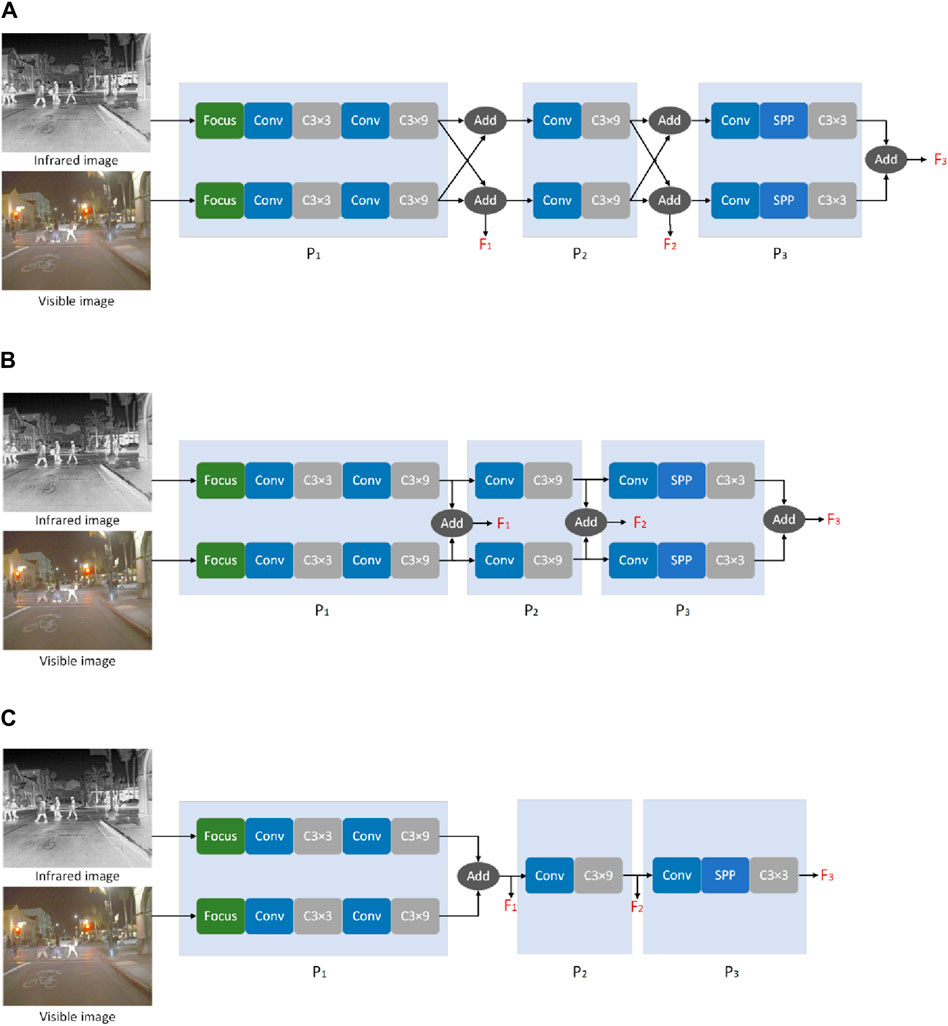
Figure 8. Frameworks for investigating cross-modal interactions. (A) Subnetwork at connections, (B) model structure, (C) network to further extracted the deeper features.
The model structure is shown in Figure 8B. Fuse model-3 extracts the features of the source image in the
3 Experiments and results
3.1 Dataset with experimental details
In this paper, we use the FLIR public dataset to train and validate the algorithm model. The FLIR dataset is an autonomous driving scene dataset containing road target images captured under complex daytime and nighttime conditions, with 4,129 pairs of infrared and visible images in the training set and 1,010 pairs in the test set. In this paper, three types of targets, namely, pedestrians (person), vehicles (car) and bicycles (bicycle), were selected, and the target attributes of the training set were counted, as shown in Figure 9. Figure 9 shows the (a) target number distribution, (b) target centroid distribution, and (c) target size distribution. Figure 9 shows the number of targets in the three categories varies widely and the categories are seriously unbalanced, with vehicle targets far outnumbering pedestrian and bicycle targets. The statistics on the distribution of target centroid
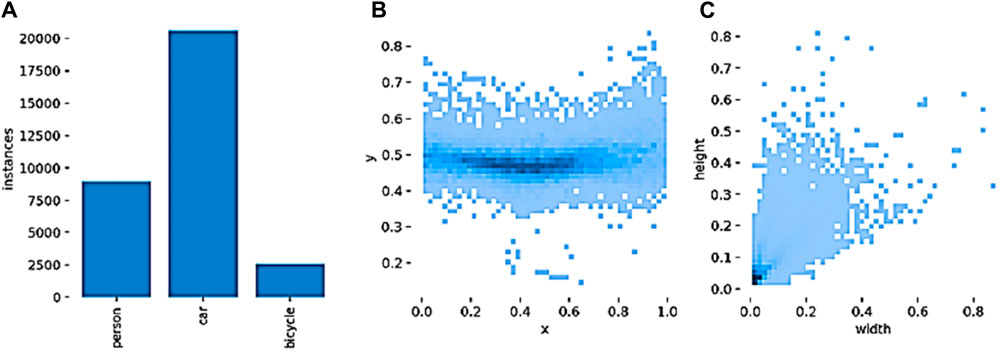
Figure 9. (A) Object attribute statistics, (B) Target Distribution and (C) Attributes in the FLIR Dataset.
The study conducted an analysis of distance statistics to investigate the distinctness and complementary nature of different modalities in capturing information about pedestrians. The researchers focused on comparing the distances between pedestrian samples in the visible range and infrared. The results demonstrated significant differences between the distances observed in the visible range alone and those obtained in the infrared modality. This indicates that the two modalities capture unique information about pedestrians, with the visible range emphasizing visual appearance and shape, while the infrared modality highlights thermal signatures and motion patterns. Furthermore, the study examined the cross-distance between the fused representation and the individual modalities. The findings revealed that the cross-distance was significantly smaller compared to the distances within each modality. This indicates that the fused representation successfully integrates the distinct information from both modalities, resulting in an embedding that is closer to each individual modality. Before model training, in addition to conventional data enhancement methods such as the random cropping, horizontal flipping, vertical flipping and proportional scaling of images, the mosaic data enhancement method was used to randomly stitch 4 images to prevent overfitting. The experimental environment used an I9-109000k CPU, 32 GB RAM, NVIDIA 3090 TI video card and 24 GB video memory. The optimizer used in YOLOv5 is stochastic gradient descent (SGD) [21]. In YOLOv5, the default parameters were used, and anchor box sizes of [10, 16, 30, 55] were used as the detection frames for small, medium and large targets. The values of
3.2 Evaluation indicators
In this paper, we used the mean average precision (mAP) to evaluate the detection results, and the definition is described below. The intersection over union (IoU) refers to the ratio of the intersection of the real frame and the predicted frame to the merged set.
For the target detection problem, suppose the threshold is
When calculating the metrics, the IoU is fixed at a threshold of
where
3.3 Experimental analysis
To illustrate the difference between human perception and machine perception, we give the multi-scale features extracted by the algorithm and their corresponding fusion results, and the visualization results of the features for machine perception are shown in the Figure 10. In the low-dimensional feature extraction with more detailed features, the higher-order features reflect the semantic features of the image. The fused features are generated from the multiscale features of both bands and finally help in image detection. In the model, the fused features are optimized by the loss function achieved by the detection, i.e., the features on which the detection depends, are completely unfavorable to human observation.
Figure 10 visually illustrates the multi-scale features and fused outcome achieved through our novel spatial perception method. The figure showcases the effectiveness of our approach in integrating dual-modality feature fusion and coupled attention mechanisms, resulting in enhanced target detection performance through the fusion of cross-modal information.
Figure 11 illustrates a qualitative comparison of dual-band object detection outcomes specifically in nighttime scenes, serving as a visual representation of the proposed spatial perception method’s performance and efficacy in low-light conditions. Figure 11 presents a side-by-side evaluation of the detection results achieved using the proposed algorithm, featuring a collection of nighttime scenes captured using dual-band modalities. Each scene showcases the highlighted and labeled detected objects, along with their respective classes and bounding boxes. Figure 12 compares dual-band object detection results in daytime scenes, highlighting the effectiveness of the proposed spatial perception method. Figure 12 shows a side-by-side analysis of detection outcomes using the algorithm, showcasing labeled objects in dual-band imagery. This visual comparison allows readers to assess the algorithm’s performance in accurately identifying and localizing objects in well-lit conditions. The qualitative results support the quantitative findings, emphasizing the method’s ability to enhance target detection. Figure 12 also demonstrates the method’s adaptability to different lighting conditions, reinforcing its practical applicability in real-world scenarios.
The labels from the method in this paper were compared with the labels in the FLIR ADAS dataset, and the dual-band target detection effects during the day and at night are shown in Figure 11, 12, respectively. Figure 11 shows the detection effect of a night scene. Most targets, such as pedestrians and vehicles, cannot be easily detected by human eyes in the visible image, but they are more prominent in the infrared image. The algorithm in this paper completely detects pedestrians, vehicles and other targets in all three scenes. In Scene II, the algorithm in this paper detects two small vehicle targets that are not labeled (see red marks in the Figure 11), and in Scene III, it can detect most of the pedestrians that are obscured by vehicles. Figure 12 shows the detection effect of the algorithm in daytime scenes. The image quality of the visible image in daytime is significantly improved, while the prominence of the targets in the infrared image is slightly reduced, and the surrounding area of the targets is blurred. The results of this algorithm are more accurate than those based on manual annotation. Subjective observation shows that the algorithm is able to exploit the advantages of infrared and visible images. The detection performance is accurate and stable in daytime and nighttime scenes and is not easily affected by lighting and other factors.
To verify the effectiveness of the dual-band fusion target detection algorithm, the algorithm in this paper was compared with the single-band detection model. The dual-band target detection algorithm GPT [22], YOLOv5, and the model in this paper are all used as pretrained models. YOLOv5 is a unimodal model trained on visible and infrared images together and tested on the visible and infrared images in the test set. The training set and parameters of the GPT algorithm and the algorithm in this paper are the same. In this section, the precision, recall, mAP50, mAP75 and mAP metrics were used for quantitative comparison, and the results are shown in Table 1.
From the Table, it can be obtained that compared with visible single-mode target detection, the algorithm in this paper improves 18.9% and 30.4% in mAP50 and mAP, respectively. Compared with the single-mode infrared detection results, the algorithm in this paper improves 1.8% and 3.0% in mAP50 and mAP metrics, respectively, indicating that multi-band fusion detection can improve the detection effect; compared with GPT multimodal detection algorithm, mAP50 and mAP improve 1.1% and 3.5%, respectively. In addition to the average accuracy, the algorithm in this paper balances up in the accuracy and recall metrics, indicating that the combined multi-band information can reduce the false detection rate.
To verify the effectiveness of the model in daytime and nighttime scenes, the FLIR test set was split into daytime and nighttime datasets and tested separately, with 700 pairs of images in the daytime dataset and 310 pairs of images in the nighttime dataset, and the test results are shown in Table 2. From this table, it can be seen that visible light images are more influenced by light factors, and targets in dark or glare conditions cannot be detected. Thus, the average accuracy of detection at night is significantly lower than that during the day. The contrast of infrared images in the FLIR dataset is relatively low in daytime and the edges are more blurred, so the average accuracy of detection in the infrared band at night is higher than that in daytime, which is in line with the characteristics of infrared and visible light imaging. In addition, because some of the images in the FLIR dataset are not aligned at the pixel level and the labels in the dataset are labeled according to the infrared images, there are problems with missing labels and bounding box shifts, resulting in the detection accuracy index of the visible band and the fusion algorithm being affected to some extent. Taken together, the algorithm proposed in this paper is able to perform in a stable manner for a variety of complex scenes, regardless of illumination.
To verify the impact of the proposed feature fusion module on target detection, the model was retrained by replacing the feature fusion module with a summation layer (see Figure 4A for the model structure) while keeping the training data, basic network model and parameters unchanged, and the test results on the FLIR test set are shown in Table 3. The model including the feature fusion module can improve 1.75%, 7.80%, 4.84% and 5.32% in Precision, Recall, mAP50 and mAP indexes, respectively, indicating that the feature fusion module proposed in this paper can effectively fuse important complementary features of IR and visible images and significantly improve the detection performance compared with simple summation for fusion.
This paper introduces three fusion models, namely, Fuse model-1, Fuse model-2, and Fuse model-3, designed to investigate the impact of different fusion methods on target detection accuracy. The experimental results, presented in Table 4, focus on the FLIR test set, with only the network model being modified while keeping other factors unchanged. The optimal values of the three models are indicated in bold. Fuse model-1 achieves the highest accuracy rate, Fuse model-2 exhibits the highest recall and average precision, and Fuse model-3 demonstrates the highest average precision at an Intersection over Union (IoU) threshold of 0.5.
Both Fuse model-2 and Fuse model-3 perform comparably. However, Fuse model-1 falls short, indicating a significant disparity between infrared and visible features. The simple feature summation fusion employed in the dual-stream architecture fails to achieve the desired effect of feature complementarity. To address this limitation, the proposed algorithm in this paper improves upon the framework of Fuse model-1, resulting in a significant enhancement in performance. These findings suggest that the proposed feature fusion module effectively integrates complementary information from infrared and visible bands, thereby enhancing target detection performance.
4 Conclusion
The target detection accuracy of visible or infrared single-band images depends on the imaging quality, and dual-band images can provide complementary information to enhance the stability and reliability of the detection system. To verify the effectiveness of the dual-band information in improving the detection of the target, this paper proposes a dual-band target detection framework based on feature fusion applied to infrared and visible target detection. In our method, infrared and visible features are extracted separately through a dual-stream architecture and integrated through a feature fusion module based on a linear transformer and channel attention. Taken together, the combination of cross-modal features significantly improves target detection accuracy and provides strong adaptability and robustness in both day and night scenes, exploiting the complementary advantages of visible and IR images. In addition, due to the adaptive nature of the fusion strategy, the algorithm in this paper is expected to be applicable to other types of multimodal remote sensing imaging detection tasks. The study introduces a dual-stream architecture to separately extract features from infrared and visible images. These features are then fused using a linear transformer and a channel attention-based fusion module. This adaptive fusion approach enables the learning of interrelationships between different modalities without the need for manually designed fusion rules. Experimental results on the FLIR dataset demonstrate that the proposed method significantly outperforms single-modality detection baselines, achieving an average accuracy improvement of over 30% compared to visible image detection. The algorithm also demonstrates robust performance in both day and night scenes. Through visualization and quantitative evaluation, this research validates that cross-modal data fusion can indeed enhance a system’s perceptual capabilities for tasks such as target detection.
Data availability statement
The original contributions presented in the study are included in the article/Supplementary material, further inquiries can be directed to the corresponding author.
Author contributions
NZ: Conceptualization, Data curation, Formal Analysis, Funding acquisition, Writing–original draft. WZ: Conceptualization, Data curation, Formal Analysis, Funding acquisition, Writing–original draft.
Funding
The author(s) declare that no financial support was received for the research, authorship, and/or publication of this article.
Conflict of interest
The authors declare that the research was conducted in the absence of any commercial or financial relationships that could be construed as a potential conflict of interest.
Publisher’s note
All claims expressed in this article are solely those of the authors and do not necessarily represent those of their affiliated organizations, or those of the publisher, the editors and the reviewers. Any product that may be evaluated in this article, or claim that may be made by its manufacturer, is not guaranteed or endorsed by the publisher.
References
1. Girshick R, Donahue J, Darrell T, Malik J, Rich feature hierarchies for accurate object detection and semantic segmentation. In: Proceedings of the IEEE conference on computer vision and pattern recognition (2014). p. 580–7.
2. Girshick R Fast r-cnn. In: Proceedings of the IEEE international conference on computer vision (2015). p. 1440–8.
3. Ren S, He K, Girshick R, Sun J, Faster r-cnn: towards real-time object detection with region proposal networks. Adv Neural Inf Process Syst (2015) 28. doi:10.1109/TPAMI.2016.2577031
4. He K, Gkioxari G, Dollár P, Girshick R, Presents the front cover of the proceedings record. In: IEEE international conference on computer vision (2017). p. 2961–9.
5. Liu W, Anguelov D, Erhan D, Szegedy C, Reed S, Fu CY, et al. Ssd: single shot multibox detector. In: Computer Vision–ECCV 2016: 14th European Conference Proceedings, Part I 14; October 11–14, 2016; Amsterdam, The Netherlands. Springer International Publishing (2016). p. 21–37.
6. Redmon J, Divvala S, Girshick R, Farhadi A, You only look once: unified, real-time object detection. In: Proceedings of the IEEE conference on computer vision and pattern recognition (2016). p. 779–88.
7. Redmon J, Farhadi A, YOLO9000: better, faster, stronger. In: Proceedings of the IEEE conference on computer vision and pattern recognition (2017). p. 7263–71.
8. Lin TY, Goyal P, Girshick R, He K, Dollár P, Focal loss for dense object detection. In: Proceedings of the IEEE international conference on computer vision (2017). p. 2980–8.
9. Hwang S, Park J, Kim N, Choi Y, So Kweon I, Multispectral pedestrian detection: benchmark dataset and baseline. In: Proceedings of the IEEE conference on computer vision and pattern recognition (2015). p. 1037–45.
10. Wagner J, Fischer V, Herman M, Behnke S, Multispectral pedestrian detection using deep fusion convolutional neural networks. In ESANN (2016) 587:509–14.
11. Dollár P, Appel R, Belongie S, Perona P, Fast feature pyramids for object detection. IEEE Trans pattern Anal machine intelligence (2014) 36(8):1532–45. doi:10.1109/tpami.2014.2300479
12. Konig D, Adam M, Jarvers C, Layher G, Neumann H, Teutsch M, Fully convolutional region proposal networks for multispectral person detection. In: Proceedings of the IEEE conference on computer vision and pattern recognition workshops (2017). p. 49–56.
13. Li C, Song D, Tong R, Tang M, Illumination-aware faster R-CNN for robust multispectral pedestrian detection. Pattern Recognition (2019) 85:161–71. doi:10.1016/j.patcog.2018.08.005
14. Guan D, Cao Y, Yang J, Cao Y, Yang MY, Fusion of multispectral data through illumination-aware deep neural networks for pedestrian detection. Inf Fusion (2019) 50:148–57. doi:10.1016/j.inffus.2018.11.017
15. Zhang L, Liu Z, Zhang S, Yang X, Qiao H, Huang K, et al. Cross-modality interactive attention network for multispectral pedestrian detection. Inf Fusion (2019) 50:20–9. doi:10.1016/j.inffus.2018.09.015
16. Zhang H, Fromont E, Lefevre S, Avignon B, Multispectral fusion for object detection with cyclic fuse-and-refine blocks. In: 2020 IEEE International conference on image processing (ICIP). IEEE 2020 (2020, October). p. 276–80.
17. Zhang H, Fromont E, Lefèvre S, Avignon B Guided attentive feature fusion for multispectral pedestrian detection. In: Proceedings of the IEEE/CVF winter conference on applications of computer vision (2021). p. 72–80.
18. Vaswani A, Shazeer N, Parmar N, Uszkoreit J, Jones L, Gomez AN, et al. Attention is all you need. Adv Neural Inf Process Syst (2017) 30. doi:10.48550/arXiv.1706.03762
19. Katharopoulos A, Vyas A, Pappas N, Fleuret F Transformers are rnns: Fast autoregressive transformers with linear attention. In: Proceedings of the 37th International Conference on Machine Learning, PMLR (2020). Vol. 119, p. 5156–5165.
20. Rezatofighi H, Tsoi N, Gwak J, Sadeghian A, Reid I, Savarese S Generalized intersection over union: a metric and a loss for bounding box regression. In: Proceedings of the IEEE/CVF conference on computer vision and pattern recognition (2019). p. 658–66.
21. Bottou L, Curtis FE, Nocedal J Optimization methods for large-scale machine learning. SIAM Rev (2018) 60(2):223–311. doi:10.1137/16m1080173
22. Qingyun F, Dapeng H, Zhaokui W Cross-modality fusion transformer for multispectral object detection (2021). Available from: https://arxiv.org/abs/2111.00273 (Accessed 2021).
23. Diwan T, Anirudh G, Tembhurne JV Object detection using YOLO: challenges, architectural successors, datasets and applications. multimedia Tools Appl (2023) 82(6):9243–75. doi:10.1007/s11042-022-13644-y
24. Zhu L, Xie Z, Liu L, Tao B, Tao W Iou-uniform r-cnn: breaking through the limitations of rpn. Pattern Recognition (2021) 112:107816. doi:10.1016/j.patcog.2021.107816
25. Tahir NUA, Long Z, Zhang Z, Asim M, Elaffendi M PVswin-YOLOv8s: UAV-based pedestrian and vehicle detection for traffic management in smart cities using improved YOLOv8. Drones (2024) 8(3):84. doi:10.3390/drones8030084
26. Tahir NUA, Zhang Z, Asim M, Chen J, Elaffendi M Object detection in autonomous vehicles under adverse weather: a review of traditional and deep learning approaches. Algorithms (2024) 17(3):103. doi:10.3390/a17030103
27. Xuan H, Luo L, Zhang Z, Yang J, Yan Y Discriminative cross-modality attention network for temporal inconsistent audio-visual event localization. IEEE Trans Image Process (2021) 30:7878–88. doi:10.1109/tip.2021.3106814
28. Xie B, Milam G, Ning B, Cha J, Park CH DXM-TransFuse U-net: dual cross-modal transformer fusion U-net for automated nerve identification. Comput Med Imaging Graphics (2022) 99:102090. doi:10.1016/j.compmedimag.2022.102090
29. Liu X, Luo Y, Yan K, Chen J, Lei Z CMC2R: cross-modal collaborative contextual representation for RGBT tracking. IET Image Process (2022) 16(5):1500–10. doi:10.1049/ipr2.12427
30. Feng F, Ming Y, Hu N SSLNet: a network for cross-modal sound source localization in visual scenes. Neurocomputing (2022) 500:1052–62. doi:10.1016/j.neucom.2022.05.098
31. Cai Y, Sui X, Gu G, Chen Q Learning modality feature fusion via transformer for RGBT-tracking. Infrared Phys Tech (2023) 133:104819. doi:10.1016/j.infrared.2023.104819
32. Wang H, Song K, Huang L, Wen H, Yan Y Thermal images-aware guided early fusion network for cross-illumination RGB-T salient object detection. Eng Appl Artif Intelligence (2023) 118:105640. doi:10.1016/j.engappai.2022.105640
33. Lv XL, Chiang HD Visual clustering network-based intelligent power lines inspection system. Eng Appl Artif Intelligence (2024) 129:107572. doi:10.1016/j.engappai.2023.107572
34. Li T, Wang Z The bifurcation of constrained optimization optimal solutions and its applications. AIMS Math (2023) 8(5):12373–97. doi:10.3934/math.2023622
35. Chen J, Song Y, Li D, Lin X, Zhou S, Xu W Specular removal of industrial metal objects without changing lighting configuration. IEEE Trans Ind Inform (2023) 20:3144–53. doi:10.1109/tii.2023.3297613
36. Xu H, Li Q, Chen J Highlight removal from a single grayscale image using attentive GAN. Appl Artif Intelligence (2022) 36(1):1988441. doi:10.1080/08839514.2021.1988441
37. Li J, Han L, Zhang C, Li Q, Liu Z Spherical convolution empowered viewport prediction in 360 video multicast with limited FoV feedback. ACM Trans Multimedia Comput Commun Appl (2023) 19(1):1–23. doi:10.1145/3511603
38. Li J, Zhang C, Liu Z, Hong R, Hu H Optimal volumetric video streaming with hybrid saliency based tiling. IEEE Trans Multimedia (2022) 25:2939–53. doi:10.1109/tmm.2022.3153208
39. Chen J, Wang Q, Peng W, Xu H, Li X, Xu W Disparity-based multiscale fusion network for transportation detection. IEEE Trans Intell Transportation Syst (2022) 23(10):18855–63. doi:10.1109/tits.2022.3161977
40. Zhang R, Li L, Zhang Q, Zhang J, Xu L, Zhang B, et al. The effect of two facets of physicians' environmental stress on patients' compliance with COVID-19 guidelines: moderating roles of two types of ego network. IEEE Trans Circuits Syst Video Tech (2023) 1–25. doi:10.1080/08870446.2023.2295902
41. Di Y, Li R, Tian H, Guo J, Shi B, Wang Z, et al. A maneuvering target tracking based on fastIMM-extended Viterbi algorithm. Neural Comput Appl (2023) 1–10. doi:10.1007/s00521-023-09039-1
42. Zhu J, Dang P, Zhang J, Cao Y, Wu J, Li W, et al. The impact of spatial scale on layout learning and individual evacuation behavior in indoor fires: single-scale learning perspectives. Int J Geographical Inf Sci (2024) 38(1):77–99. doi:10.1080/13658816.2023.2271956
43. Zhang H, Liu H, Kim C Semantic and instance segmentation in coastal urban spatial perception: a multi-task learning framework with an attention mechanism. Sustainability (2024) 16(2):833. doi:10.3390/su16020833
44. Cao X, Huang X, Zhao Y, Sun Z, Li H, Jiang Z, et al. A method of human-like compliant assembly based on variable admittance control for space maintenance. Cyborg Bionic Syst (2023) 4:0046. doi:10.34133/cbsystems.0046
45. Ma D, Fang H, Wang N, Lu H, Matthews J, Zhang C Transformer-optimized generation, detection, and tracking network for images with drainage pipeline defects. Computer-Aided Civil Infrastructure Eng (2023) 38(15):2109–27. doi:10.1111/mice.12970
46. Zhao X, Fang Y, Min H, Wu X, Wang W, Teixeira R Potential sources of sensor data anomalies for autonomous vehicles: an overview from road vehicle safety perspective. Expert Syst Appl (2023) 121358. doi:10.1016/j.eswa.2023.121358
47. Ma S, Chen Y, Yang S, Liu S, Tang L, Li B, et al. The autonomous pipeline navigation of a cockroach bio-robot with enhanced walking stimuli. Cyborg Bionic Syst (2023) 4:0067. doi:10.34133/cbsystems.0067
48. Qian J, Cao Y, Bi Y, Wu H, Liu Y, Chen Q, et al. Structured illumination microscopy based on principal component analysis. ELight (2023) 3(1):4. doi:10.1186/s43593-022-00035-x
49. Jiang H, Xie Y, Zhu R, Luo Y, Sheng X, Xie D, et al. Construction of polyphosphazene-functionalized Ti3C2TX with high efficient flame retardancy for epoxy and its synergetic mechanisms. Chem Eng J (2023) 456:141049. doi:10.1016/j.cej.2022.141049
50. Shi Y, Xi J, Hu D, Cai Z, Xu K RayMVSNet++: learning ray-based 1D implicit fields for accurate multi-view stereo. IEEE Trans Pattern Anal Machine Intelligence (2023) 45:13666–82. doi:10.1109/tpami.2023.3296163
51. Dong Y, Xu B, Liao T, Yin C, Tan Z Application of local-feature-based 3-D point cloud stitching method of low-overlap point cloud to aero-engine blade measurement. IEEE Trans Instrumentation Meas (2023) 72:1–13. doi:10.1109/tim.2023.3309384
52. Zhou P, Qi J, Duan A, Huo S, Wu Z, Navarro-Alarcon D Imitating tool-based garment folding from a single visual observation using hand-object graph dynamics. IEEE Trans Ind Inform (2024) 20:6245–56. doi:10.1109/tii.2023.3342895
53. Zhao J, Song D, Zhu B, Sun Z, Han J, Sun Y A human-like trajectory planning method on a curve based on the driver preview mechanism. IEEE Trans Intell Transportation Syst (2023) 24:11682–98. doi:10.1109/tits.2023.3285430
54. Jiang Y, Yang Y, Xu Y, Wang E, Spatial-temporal interval aware individual future trajectory prediction. IEEE Trans Knowledge Data Eng (2023) 1–14. doi:10.1109/tkde.2023.3332929
Keywords: spatial perception, cross-modal data fusion, dual-modality feature fusion, target detection performance, multi-scale feature extraction, dual-band feature fusion
Citation: Zhang N and Zhu W (2024) Enhancing target detection accuracy through cross-modal spatial perception and dual-modality fusion. Front. Phys. 12:1398678. doi: 10.3389/fphy.2024.1398678
Received: 10 March 2024; Accepted: 10 May 2024;
Published: 06 June 2024.
Edited by:
Wenfeng Xia, King’s College London, United KingdomReviewed by:
Shahaf Asban, University of South Florida, United StatesMuhammad Asim, Guangdong University of Technology, China
Copyright © 2024 Zhang and Zhu. This is an open-access article distributed under the terms of the Creative Commons Attribution License (CC BY). The use, distribution or reproduction in other forums is permitted, provided the original author(s) and the copyright owner(s) are credited and that the original publication in this journal is cited, in accordance with accepted academic practice. No use, distribution or reproduction is permitted which does not comply with these terms.
*Correspondence: Ning Zhang, am9qZW5tbkBvdXRsb29rLmNvbQ==
 Ning Zhang
Ning Zhang Wenqing Zhu1,2,3
Wenqing Zhu1,2,3